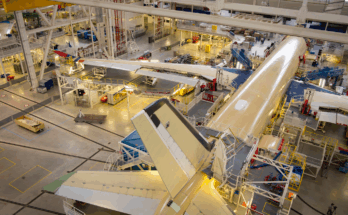Boeing Delivers Record 762 Jets in 2015. Airbus Wins Orders Race.
By J. Kasper Oestergaard, European Correspondent.
Boeing and Airbus delivered 53 and 79 commercial jets in December 2015, respectively, compared to 71 and 61 in November. December deliveries were unusually low for Boeing and unusually high for Airbus, which might indicate some year-end “fiddling” to reach desired 2015 totals. In 2015, Boeing delivered 762 aircraft, ahead of Airbus’ 635. Both Boeing and Airbus beat their 2015 delivery targets of 750-755 and ~630 aircraft, respectively. Boeing saw its lead in the 2015 delivery race be reduced to 127 units, from 153 units in November and 143 units in October. In 2014 and 2013, Boeing delivered a total of 723 and 648 jets, respectively, compared to Airbus’ 629 and 626. Boeing has been able to increase deliveries significantly in recent years, mainly due to the ramp-up in production of the 787 Dreamliner (135 delivered in 2015). Airbus is slowly ramping up deliveries of its A350 XWB and this, combined with a higher A320 production rate of 46 per month from Q2 2016, means that the company will soon begin narrowing the gap in the deliveries race. In December, Airbus delivered four A350s and it has delivered 15 aircraft to date (the first aircraft was delivered in December 2014). The company expects to deliver more than 100 A350s in 2018, when the production rate will hit 10 per month (the current 787 production rate).
In the orders race, Airbus had a very quiet month and booked just 29 net new orders (orders for 60 aircraft minus 31 cancellations), increasing its 2015 total to 1,036. During the month of December, Airbus landed 36 orders for the A319/A320/A321neo, including Turkish Airlines’ order for 20 additional A321neo aircraft. Airbus’ December widebody orders included three A380 superjumbos from an unidentified customer, along with bookings for two A350-900s. On another note, AirAsia X converted an order for 11 A330-300 aircraft to new A330-900s. Boeing had a strong month of December and booked net new orders for 200 aircraft, or 223 in total, including 118 737 MAX aircraft and 101 737NGs. The vast majority of these orders were from unidentified customers. Boeing plans to raise its 737 production rate to 47 and 52 per month in 2017 and 2018, respectively. Boeing finished 2015 with 768 net new orders, or 268 fewer than Airbus. In both 2014 and 2013, Airbus won the orders race with 1,456 and 1,503 net new orders, respectively, ahead of Boeing with 1,432 and 1,355. In 2015, net new orders for both Boeing and Airbus were significantly down from the 2014 levels, due, among other factors, to the sharp decline in the price of oil. Cheaper oil makes it financially more attractive for airlines to keep operating older, less fuel- efficient aircraft.
As Airbus recorded only 29 net new orders in December, Airbus’ order backlog stands at 6,787 jets (of which 5,535, or 81.6%, are A320 narrowbody jets), ahead of Boeing with 5,795 (of which 4,392, or 75.8%, are 737 narrowbodies). While Boeing experienced a declining backlog through October 2015 due to a slump in orders, the company finished the year in great form with, as indicated above, 200 net new orders in December, and was able to grow its backlog by six units for the year to reach 5,795 jets.
Risk of Boeing 777 Rate Cut
Both Boeing and Airbus are facing challenges going forward. Boeing is struggling to bridge the gap in production between its current-generation 777 (777F and 777-300ER) and the future 777X to maintain the current production rate of 8.3 per month (100 per year). The 777 is a very profitable aircraft for Boeing and an important “cash cow.” It will be difficult for the company to bridge the gap, as not enough orders are coming in for the current-generation 777. In 2015, Boeing only booked 38 orders for the 777 (16 777Fs and 22 777-300ERs), and it is more than likely that the company will be forced to cut the rate to first seven per month (84 per year) and later six per month (72 per year).
Airbus Ramping Up A320 and A350 Output
Airbus faces challenges now that production and deliveries of the A350 XWB will be ramping up. The company plans to produce 10 aircraft per month by 2018. Also, the company plans to increase the monthly production rate of the A320 to 46 this year and to 60 by mid-2019. Airbus officially opened its A320 final assembly line in Mobile, Alabama, the company’s first production site in America. Deliveries from Mobile are scheduled to begin in 2016 and to reach an annual output of 40 to 50 A320 series jets by 2018.
A380 Uncertainty
Another major challenge for Airbus centers on the future of the A380 as the company considers launching NEO and stretch variants of the aircraft. The company has to make a tough choice: either 1) invest billions in developing the NEO and stretch to reduce the aircraft’s cost per seat mile; or 2) phase out the platform and terminate production when orders run out in four or five years. In December 2015, after a long order drought, Airbus was able to book an order for three A380 superjumbos from an unidentified customer. According to various reports from Japanese media, the unidentified buyer is All Nippon Airways (ANA). News reports indicate that ANA will deploy the A380 on flights to Hawaii, among other destinations. ANA was the launch customer for the 787 Dreamliner and is also a future 777X customer. It currently operates an all-Boeing widebody fleet.
http://www.boeing.com/commercial/#/orders-deliveries
http://www.airbus.com/company/market/orders-deliveries/
http://www.airbus.com/company/americas/us/alabama/
http://airwaysnews.com/blog/2016/01/04/nh-set-to-order-a380s/
http://atwonline.com/airbus-a380/ana-a380-deal-not-decided
A military history enthusiast, Richard began at Forecast International as editor of the World Weapons Weekly newsletter. As the Internet grew in importance as a research tool, he helped design the company's Forecast Intelligence Center and currently coordinates the EMarket Alert newsletters for clients. Richard also manages social media efforts, including two new blogs: Defense & Security Monitor, covering defense systems and international issues, and Flight Plan, which focuses on commercial aviation and space systems. For over 30 years, Richard has authored the Defense & Aerospace Companies, Volume I (North America) and Volume II (International) services. The two books provide detailed data on major aerospace and defense contractors. He also edits the International Contractors service, a database that tracks all the contractors involved in the programs covered in the FI library. More recently he was appointed Manager, Information Services Group (ISG), a new unit that encompasses developing outbound content for both Forecast International and Military Periscope.






